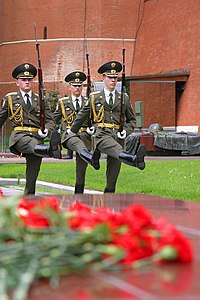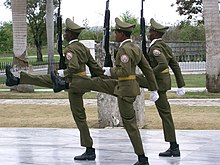Goose step

Der Stechschritt [1] (literally: piercing step), commonly known in English speaking countries as "the Goose-Step", is a special form of military step, which is usually demonstrated in solemn military parades and passes in review of closed units. The marching troops swing their legs from a vertical leg to a nearly horizontally-extending one, bringing it down with a loud simultaneous stepping noise and continuing the cycle in unison. It emerged from Prussian drilling regulation during the early 19th Century.
History
The goose-step takes much practice and dexterity, and so the purpose of the goose-step is the demonstration of absolute mechanized discipline and superiority. Some, such as George Orwell, feel that the goose-step is also intended to look ridiculous, as Orwell said in his 1940 essay The Lion and the Unicorn:
[Goose-Stepping] is simply an affirmation of naked power; contained in it, quite consciously and intentionally, is the vision of a boot crashing down on a face. Its ugliness is part of its essence, for what it is saying is "Yes, I am ugly, and you daren't laugh at me", like the bully who makes faces at his victim… Beyond a certain point, military display is only possible in countries where the common people dare not laugh at the army.
Goose-stepping is commonly associated today with the German armed forces of the Reichswehr and of the Wehrmacht during the Third Reich. However, other armies have historically practiced goose-stepping or similar variations, such as the Imperial Russian Army. Benito Mussolini introduced it in 1938 as Passo Romano ("Roman step") in the Italian army.
The use of the goose-step was severely curtailed in the Wehrmacht after the fall of France in 1940 and recruits in training were not taught it. Even earlier, it was reserved only for special parades, and required several days of practice to ensure troops were fit and able to perform without injuring themselves. Preparatory training would include soldiers marching in small groups with arms locked in order to maintain their balance and become used to the physical exertions required. Later in the war, manpower shortages, restrictions in training time, and a paucity of appropriate occasions made the goose-step disappear from sight as the army concentrated on combat training.
After the end of the Second World War a reduced form of the goose-step (boot point in knee height) was still used by the East German National People's Army under the name drilling step to avoid references to old Prussian or Wehrmacht military tradition.
In the Soviet Union and the later Russian Federation, various military units practice a form of goose-stepping at such occasions as the anniversary of the October Revolution. They follow the model of the Imperial Russian army, which practiced a version of goose-stepping.

In countries such as North Korea, China, Cuba or Vietnam, whose military forces are shaped by the Soviet model, it is still regularly demonstrated.
The Chilean military, which borrows much of its traditions from the Germans, still practices goose-steps on ceremonial occasions.
The Iranian army's tradition of goose-stepping during military parades has continued despite the Iranian Revolution of 1979.
Popular culture
- In all three versions of The Producers goose-stepping Nazi Stormtroopers are seen prominently throughout its main musical number Springtime for Hitler. In the lyrics we also hear "Goose-step's our new step today!".
- "The Goose-Step" is a political cartoon by E. H. Shepard, drawn in 1936 critical of the Nazis.
- People in marching bands, when performing various kinds of step similar to the Goose-Step (for instance, the highstep) are warned to avoid "the Nazi," which has become band terminology for the Goose-Step.
- In Roberto Benigni's "Life is Beautiful" Benigni (as the character Guido) mocks the German goose-step as he is marched off to his death by a Nazi soldier in order to retain the illusion of hope for his young son hiding nearby.

- In the film and concert of Pink Floyd's The Wall, a famous scene is animated goosestepping hammers, which represent creation and destruction, the functions of a hammer, and also the functions of Nazism and Fascism.
See also
External Links
- Video of russian soldiers marching in goose step (youtube.com, 0:29 min)
References
- this article contains text originally from the May 25 version of the corresponding German Wikipedia article.
- Marching Orders - Mark Scheffler, Slate.com (Jan, 2003).
